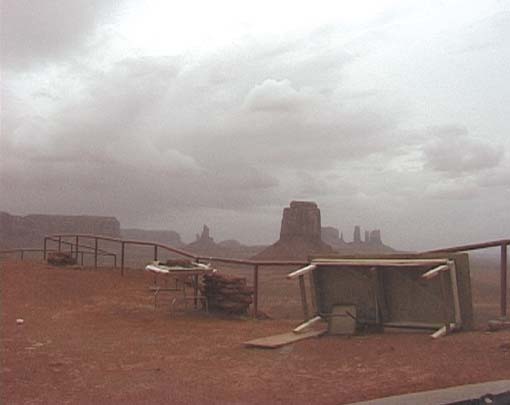| |
|||
|
|
Dorit Margreiter |
||
| |
|||
|
"Long Shot (Monument Valley)", 2001 |
||
| |
|||
| Opening Friday, November 23, 2001, 6.30 p.m. Exhibition will be opened by Dr. Christoph Mader, Office of the Tyrolean Provincial Government, Department for Culture Markus Wailand will speak about the exhibition |
|||
| |
|||
| |
Dorit Margreiter examines "everydayness", "everyday life" in terms of the conditions that created modernism, which may be outlined with the catchwords industrialization, technologization, urbanization, mediatization and globalization. She has purposely chosen the English title "Everyday Life" as a reference to the general obligation and dominance of the English language in the film and media industry and in information technology, which are among the most influential factors of globalization. Margreiter investigates the influence of the film and television industry on various models of the construction of reality in conjunction with contemporary concepts of the urban or in relation to "everyday life". In this, she makes use of several historically different models: in some cases, she refers to special models of "classical" modernism – from architecture (e.g. the "Case Study House #22" built in 1947 in Los Angeles) or from Hollywood films (e.g. the famous "Monument Valley" known primarily from westerns), which are both intertwined with the symbolically highly charged promises of modernism (the "heroic house", solitary, grand "nature"). The artist links these "classical" models with exemplary models from the "everyday life" of today: the world of advertising, of commodities such as cosmetics, and – another form of ultimate entertainment goods – US television series that are broadcast worldwide, so-called "soap operas" and "sitcoms". Margreiter draws certain
terms and methods from the field of architecture and design, as well as
from the genre of film and television, to make use of their formal and
content components for her description of the media construction of
reality: an architectonic component (e.g. Friedrich Kiesler's
TL-structure, developed in 1924) or elements from a film set or a TV
studio room are integrated prop-like in a kind of metal stage, on which
Margreiter's partly documentary, partly fictive tales find a
performance location. Another term taken from film is that of "Space Off": this refers to the space, from which a scene is filmed, which is itself not visible in the film. For Margreiter, "space off" becomes a metaphor for the overall context that generally remains hidden from the public, which co-defines the product that is for sale or consumable on TV. In her work "Space Off", these are the advertising strategies of a cosmetics company that are not made public. This company directs the advertising of its products to a certain group or class of female consumers, but Margreiter shows that this group or customer class is first created through the advertising strategies. (The product "City Block", for example, is designed for the "urban woman" subjected to the stress of the big city.) It is important to Margreiter to show how the reality of information technology, of design, of the media, advertising and commodity world penetrates "everyday life", and even becomes a structuring factor of what Henri Lefebvre has called "the concept of everydayness". According to his analysis, this is a concept that modernism alone has produced. Margreiter's dialectical approach to everyday life is evident in the way she links narrative elements with a private or documentary background, such as two works about and with her relatives from China, who now live in the USA ("Short Hills", 1999, and "Around the World, Around the World", 2001), with those derived from soap operas and sitcoms. The video "Studio City" (1999) consists of a series of shots of cities or outside views of houses. These respective TV images are establishing shots that Margreiter has taken from various television series ("Melrose Place", "Beverly Hills 90120" and others). Each of these pictures then fades into a bluescreen shot, which forms the background for short texts spoken from the off, in which friends of the artist talk about their own individual living situation. Margreiter shows the work "Everyday Life" (2001) for the first time in this exhibition. This is a multi-part video installation set up especially for the hall in the basement of the Galerie im Taxispalais. In this work, the artist concerns herself with various persons that she discovers "behind" the architecture of Los Angeles and whom she questions about their ideas of "ideal housing". She speaks with architects, photographers, historians, theorists and house owners about their personal, historical and political views. They are in a position to provide information or to contradict the architecture – and its idealized form – in which they live. Here architecture proves itself to be a facade, where what is behind it is completely separated from the outside. |
||
| |
|||
|
Catalog |
|||
| |
|||
|
